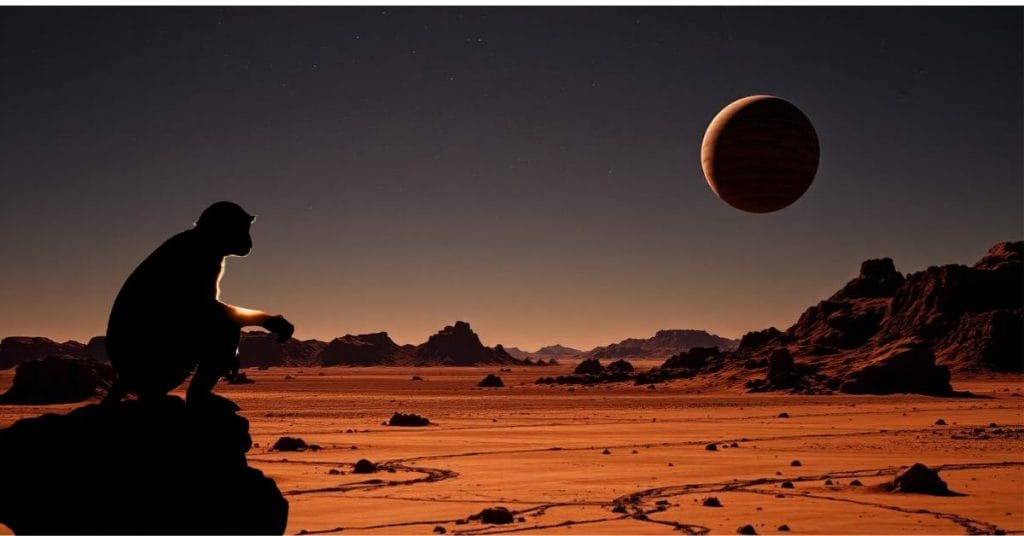Moon-watcher?
Moon-watcher is the man-ape protagonist in the opening scenes of 2001: A Space Odyssey. Several discrete groups of man-apes embody humanity’s primal origins, scavenging for food, claiming territorial rights over water and shouting at any group that might venture into that territory.
Moon-watcher leads a struggling tribe of proto-humans in a prehistoric African savanna, he and his group face starvation and threats from predators and rival tribes.
There is an encounter between the man-apes and a mysterious, now famous, monolith. This encounter marks a pivotal moment in the intellectual development of Moon-watcher, sparking a cognitive leap that awakens his curiosity and ingenuity.
Guided by the monolith’s influence, Moon-watcher discovers tool use, transforming a bone into a weapon to secure food and to defend his tribe. This act signifies the dawn of intelligence, setting humanity on a path toward technological mastery.
Clarke portrays Moon-watcher as both primitive and profound, a symbol of the evolutionary spark that propels mankind to the stars. His story frames the novel’s exploration of intelligence, technology, and cosmic destiny, inviting reflection on our origins and potential.
Moon-watcher’s transformation remains a timeless testament to the power of discovery.
What can we learn?
Moon-watcher was driven by a spark of inspiration, induced by a strange, external monolith with sides in the ratio of the squares of the first three integers. Moon-watcher didn’t understand what was happening at the time, but the lessons learned were just as important – and effective. Moon-watcher and his group embraced the experience, unknowingly, and they learned to hunt, they learned to eat meat, and they learned how to dominate the environment.
Several million years later and as a result of intellectual and technological growth and development, Moon-watcher was long gone, man-apes had evolved into man, and we had landed on the moon – interestingly the book and the film pre-dated the first moon landing. The moon survey in the book (and the film) identified a magnetic anomaly, which when investigated, turned out to be a monolith. This black object had been buried under the surface of the moon and when exposed to sunlight for the first time in a long time, it transmitted a radio pulse in the direction of Jupiter. We are then taken on a voyage of discovery to Jupiter and beyond, where, without a doubt, lots of weird and wonderful stuff happens.
I am not advocating for 2001: A Space Odyssey to become the de facto learning standard for Card Payment solutions, but it does highlight three approaches to approaching the day after tomorrow:
- Inspiration
- Planning
- Responding to unforeseen (and foreseen) situations
Approaching the Day after Tomorrow
Whatever we are going to do, we are going to need a spark of inspiration coupled with a vision and a plan. We will also need a proper grasp of the environment in which we are operating.
Inspiration
That spark of inspiration that gives rise to ingenuity and innovation should be nurtured and should never be extinguished. Moon-watcher’s descendants travelled to Jupiter and beyond on the back of a bit of inspiration that resulted in animal bones being used as instruments of domination.
Planning
Moon-watcher could never have conceived of a world where his descendants had landed on the moon, but he was able to visualise the more immediate impact of his actions and was able to take advantage of his situation.
We might argue that Moon-watcher, seeing the consequences of his actions and therefore planning accordingly, was working towards a vision.
The Jupiter Mission in the book was conceived as a vision, and the vision materialised on the back of a solid foundation of knowledge and know-how. The Jupiter Mission would not, and could no, have gone ahead (and this also applies to real-world moon landings) if the vision was not underpinned by a sound scientific and engineering foundation.
Planning is all about extracting the essence of capabilities and constraints from the real-world and then applying them to a virtual model of a future vision.
If it doesn’t work on paper, it doesn’t work!
Responding to situations
Moon-watcher would have been able to respond to situations, and sometimes the responses would work out and sometimes they wouldn’t. He probably also grasped that if more planning was involved, the positive outcomes would probably outnumber the negative.
Responding to situations is all about understanding the potential nature of unintended actions and their consequences, and the future impact of possible contingencies that might apply.
I think we can all agree that any project can be knocked off course at any time, and these situations must be managed. Responding to these challenges as they arise, and then steering a course back to normality, demands a deep understanding of the plan and its operation.
The plan to deliver a group of astronauts to somewhere near Jupiter is without a doubt a grandiose plan, which was based on a declared endgame, or vision. The plan was always going to be complex and drew on the skills and capabilities of the HAL9000 computer to oversee the operation of the ship, allowing for the effective and efficient completion of the mission.
The plan might have been meticulously conceived, researched and developed, with every possible consequence and contingency covered, but it failed, taking the lives of all but one crew member.
Whilst everything operational and mechanical had been considered, with spare parts being carried in case of system failure and all planning and contingency fitting together perfectly, the mission failed because of a lack of understanding of the fundamental relationship between the astronauts, the HAL9000 and the truth.
Responding to situations as they arise can only be successful if the situation in which they arise is properly understood.
What have we learned?
Inspiration is important for the future and it’s important that we nurture the seeds of inspiration.
If we are going to succeed, then we must begin with a vision, but it must be achievable. The vision, whilst pushing boundaries and extending capabilities, must necessarily be limited by the current art of the possible.
Even the best laid plans can fail if the underlying framework isn’t properly understood.
Times haven’t changed anything, and it’s not magic!








